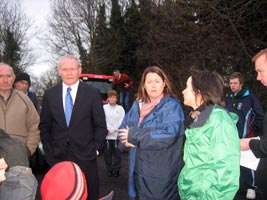3 December 2009 Edition
Deputy First Minister and MP on fact-finding visit to Fermanagh flood victims
 DEPUTY First Minister, Martin McGuinness visited the worst-affected areas of County Fermanagh last Friday and saw for himself the damage caused by the serious floods.
DEPUTY First Minister, Martin McGuinness visited the worst-affected areas of County Fermanagh last Friday and saw for himself the damage caused by the serious floods.Martin took time out to call with some of the rural dwellers caught up in the floods. He met with families who live and work in the lough shore townlands of Inisroosk, Rossmacole and Kinmore outside Lisnaskea.
The deputy First Minister, who was accompanied by Sinn Féin Fermanagh/South Tyrone MP Michelle Gildernew, Councillor Ruth Lynch and David Porter of the Rivers Agency, listened to the residents who made him aware of the difficulties they had faced over the previous week. Some have had to leave their homes for the security of other family members’ homes while others remained to look after livestock and each other.
Discussions took place with local residents as to how their concerns might be reduced should a similar period of sustained rainfall occur.
With small communities cut off and extensive damage to homes, shops and farms, the heavy rainfall of recent weeks has caused considerable hardship, especially in the low-lying areas of Fermanagh, Martin McGuinness said.
Some outlying areas of Lisnaskea and Derrylin have been accessible only by boat. Children have been unable to get to school, farmland has been ruined and animal feed destroyed. Many elderly and vulnerable people have been stranded. The deputy First Minister joined with local people to travel by tractor and boat to isolated farms and to see first-hand the damage that has been caused.
ALL-IRELAND ISSUES
Sinn Féin local representatives, in discussions with Martin McGuinness, were keen to point out the safety concerns of local people, especially in regard to children and the elderly.
Agriculture Minister Michelle Gildernew, who was with McGuinness as he toured the area, has also undertaken to do everything possible to bring help to the areas devastated by the flooding.
Michelle Gildernew said:
“None of the problems associated with the flooding can be dealt with in isolation. Here, more than in almost any sphere of life in the North, an all-Ireland perspective is required.
“The Erne system drains into the sea at Ballyshannon, and the question of co-ordinating water levels in the loch with weather conditions across the county, for example, has to be considered very closely. Issues of new house building, planning control, etc, along the Erne shores, in both jurisdictions, will have consequences on flooding and general water management.”
Fermanagh has experienced very heavy rainfall for the last number of years and experts point to the speed of climate change. The question of what measures could be taken in the short-term to alleviate the effects of regular flooding was raised in discussions between local residents, Martin McGuinness, Michelle Gildernew and Councillor Ruth Lynch.
Councillor Lynch asked:
“What are the long-term consequences of these changes for a county like Fermanagh where most people live and work along rivers or the lakes?
“We know that low-lying areas of Fermanagh are being hit by flooding every year and the problem seems to be getting worse. The people I represent need to know that everything that can be done, is being done.
“I would join with local people in thanking the deputy First Minister and the MP for acting so promptly in visiting the area and undertaking to look at what help is available.”
